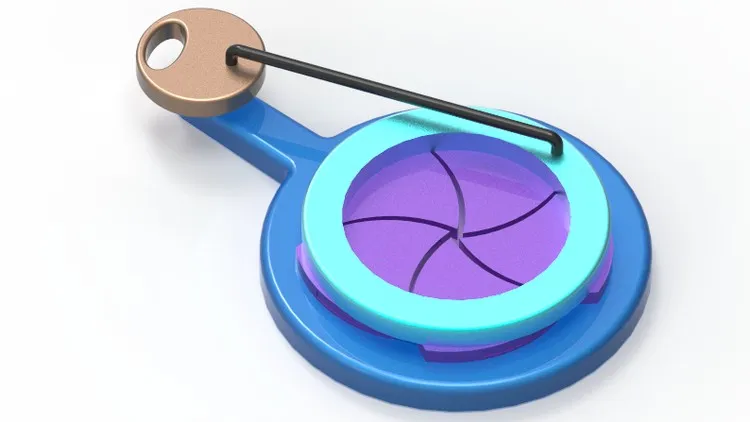
Mechanisms and motion - robotics focus 
This course will teach you the fundamentals of mechanisms and motion, with a focus on robotics. You will learn about the different types of mechanisms, how they work, and how to apply them to robot design. You will also gain an understanding of the principles of motion and how they relate to robotics. By the end of the course, you will be prepared to tackle your first Mechanical Engineering lesson at university. ▼
ADVERTISEMENT
Course Feature
![]() Cost:
Cost:
Free
![]() Provider:
Provider:
Udemy
![]() Certificate:
Certificate:
No Information
![]() Language:
Language:
English
![]() Start Date:
Start Date:
Self Paced
Course Overview
❗The content presented here is sourced directly from Udemy platform. For comprehensive course details, including enrollment information, simply click on the 'Go to class' link on our website.
Updated in [May 25th, 2023]
This course provides an introduction to the fundamentals of mechanisms and motion, with a focus on robotics. Students will gain an understanding of the principles of mechanical engineering, including kinematics, dynamics, and control systems. They will learn how to design and build robots, and how to program them to perform specific tasks. The course will also cover topics such as sensors, actuators, and power sources. By the end of the course, students will have a solid foundation in the fundamentals of robotics and be prepared for their first Mechanical Engineering lesson at university.
[Applications]
After completing this course, students should be able to apply their knowledge of mechanisms and motion to the design of robots and machines. They should be able to identify the components of a mechanism and understand how they interact to create motion. Additionally, they should be able to use their understanding of mechanisms to troubleshoot and optimize existing designs. Finally, they should be able to use their knowledge to create new designs for robots and machines.
[Career Paths]
1. Robotics Engineer: Robotics Engineers design, develop, and maintain robots and robotic systems. They are responsible for creating the algorithms and software that control the robots, as well as the hardware that makes them move. Robotics Engineers must have a strong understanding of mechanical engineering principles, as well as a good grasp of computer programming. As the demand for robots and robotic systems increases, the need for Robotics Engineers is expected to grow.
2. Automation Engineer: Automation Engineers are responsible for designing and developing automated systems and processes. They must have a strong understanding of mechanical engineering principles, as well as a good grasp of computer programming. Automation Engineers must be able to design and develop systems that are efficient, reliable, and cost-effective. As the demand for automated systems increases, the need for Automation Engineers is expected to grow.
3. Mechanical Design Engineer: Mechanical Design Engineers are responsible for designing and developing mechanical systems and components. They must have a strong understanding of mechanical engineering principles, as well as a good grasp of computer-aided design (CAD) software. Mechanical Design Engineers must be able to design and develop systems that are efficient, reliable, and cost-effective. As the demand for mechanical systems increases, the need for Mechanical Design Engineers is expected to grow.
4. Robotics Technician: Robotics Technicians are responsible for maintaining and repairing robots and robotic systems. They must have a strong understanding of mechanical engineering principles, as well as a good grasp of computer programming. Robotics Technicians must be able to troubleshoot and repair robots and robotic systems quickly and efficiently. As the demand for robots and robotic systems increases, the need for Robotics Technicians is expected to grow.
[Education Paths]
1. Mechanical Engineering: Mechanical Engineering is a broad field that focuses on the design, development, and production of machines and tools. It is a rapidly growing field, with the development of new technologies such as robotics, 3D printing, and artificial intelligence. Mechanical Engineers are responsible for the design, development, and testing of machines and tools, as well as the maintenance and repair of existing machines and tools.
2. Robotics Engineering: Robotics Engineering is a specialized field of Mechanical Engineering that focuses on the design, development, and implementation of robots. Robotics Engineers are responsible for the design, development, and testing of robots, as well as the maintenance and repair of existing robots. Robotics Engineers must have a strong understanding of mechanical engineering principles, as well as an understanding of computer programming and artificial intelligence.
3. Automation Engineering: Automation Engineering is a specialized field of Mechanical Engineering that focuses on the design, development, and implementation of automated systems. Automation Engineers are responsible for the design, development, and testing of automated systems, as well as the maintenance and repair of existing automated systems. Automation Engineers must have a strong understanding of mechanical engineering principles, as well as an understanding of computer programming and artificial intelligence.
4. Mechatronics Engineering: Mechatronics Engineering is a specialized field of Mechanical Engineering that focuses on the design, development, and implementation of mechatronic systems. Mechatronics Engineers are responsible for the design, development, and testing of mechatronic systems, as well as the maintenance and repair of existing mechatronic systems. Mechatronics Engineers must have a strong understanding of mechanical engineering principles, as well as an understanding of computer programming and artificial intelligence.
Course Syllabus
Getting Started
Class Approach & Creative Thinking
002 What is a Mechanism?
003 Building a Simple CAM and Follower
004 Eccentric Cams
005 Common Cam Types
006 Introduction to Class Files
007 Common Cam Types Applied
008 Roller Follower versus Knife Edge
009 Cam Vice Lock
010 Eccentric Cam Scissors
011 Physical Motion Compared to No Analysis
012 Eccentric Cam Versus 3 Arc Triangle
013 Scissors - Removing the Need for Spring Loading
014 Challenge: Lining Up the Scissor Blades
015 Finding the Best Mechanism for the Task
016 Constant Versus Fast Drop Motion
018 Hammer - Part 02
019 Random Combinations Drive Innovation - Learning How to Make Connections
020 Introduction to Four Bar Mechanisms
021 Output Link Sweep Area
022 Turning a 2D Sketch in 3D
023 Adding Motion to the 3D Mechanism and Changing Mechanism Lengths
024 Real World Applications - Lifting Motion
025 Adding Hydraulics for Better Precision
026 Design Improvements
027 Creating Movie Files
029 Hook and Drag - Part 02
030 Straight Line Motion
031 Hoeckens Mechanism
032 Straight Line Applications
034 Walking Machine - Part 01
035 Walking Machine - Part 02
036 Walking Machine - Part 03
037 Walking Machine - Part 04 - Building a Body Around the Mechanism
038 Four Bar - Crushing Motion
039 Crushing Motion - Part 02
041 Crushing Motion - Part 03
042 Crushing Motion - Part 04
043 Grashof Law
044 Slider Crank Mechanism Design
045 Engine Slider Crank
046 Reciprocating Saw Mechanism
047 Reciprocating Saw - Part 02
048 Reciprocating Saw - Part 03
049 Matching Guide Length with Stroke
050 Understanding Stroke Distance
051 Circle Crank
052 Slider Crank - Sewing Machine
053 Sewing Machine - Part 02
054 Slider Crank - Cutting
055 Slider Crank - Cutting - Part 02
056 - Slider Crank - Stamping Motion
057 Slotted Crank Mechanism
058 Converting Linear Motion to Circular Motion
059 Scotch Yoke
060 Scotch Yoke - Adding Functionality
061 Scotch Yoke - Vertical to Angle
062 Scotch Yoke - Changing the Stroke Length
063 Scotch Yoke - Slot to Arc
064 Scotch Yoke - Waving Hand
065 Scotch Yoke Waving Hand - Part 02
066 Scotch Yoke - Adding and Changing Images
067 - Creating Your Own Variations
068 Design Variations and Improvements
069 Design Variations and Improvements - Part 02
070 Using the Image to Create a 3D Part
071 Iris
072 Iris - Part 02
073 Iris - Part 03
074 Crank Slider Variations
What is a Hoekens Mechanism?
Mechanism Layout
2D to 3D
Linkage Assembly
Applying a Motor
Crank Slider Mechanism
Add Pump Components
Modify the Slider Motion
Assembly the Launch Components
Cam Profile Design
Model the Cam
Assemble the Cam Components
Pros & Cons

Amazing course

Good for beginners

Engaging instructor

Useful for mechanical and design engineers

Real life applications

Less content than expected

Need more calculation data reference

Beginner level course
Course Provider

Provider Udemy's Stats at AZClass
Discussion and Reviews
0.0 (Based on 0 reviews)
Explore Similar Online Courses

Free Ionic Tutorial - Rapid Prototyping with Ionic: Build a Data-Driven Mobile App

Anyone can Design: Create Awesome Graphics For Social Media

Python for Informatics: Exploring Information

Social Network Analysis

Introduction to Systematic Review and Meta-Analysis

The Analytics Edge

DCO042 - Python For Informatics

Causal Diagrams: Draw Your Assumptions Before Your Conclusions

Whole genome sequencing of bacterial genomes - tools and applications

Robotic Drives & Physics: Robotics learn by building III

Robotics: Aerial Robotics


Start your review of Mechanisms and motion - robotics focus